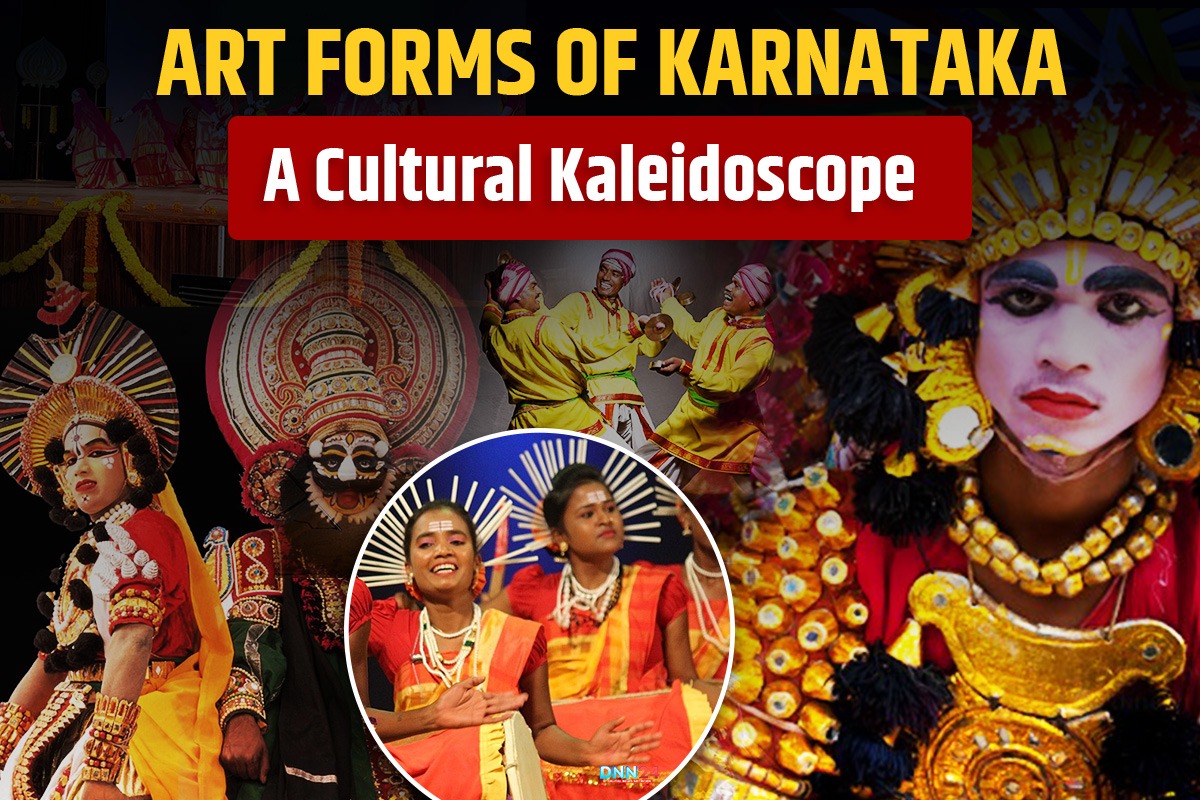The Indian state of Karnataka functions as a cultural stronghold because its varied art forms have developed over centuries. Variety of traditional art types in Karnataka represent historical growth together with religious beliefs and rural customs. The people from Karnataka display their artistry through dramatic theatrical Yakshagana performances and traditional rhythmic folk dances Dollu Kunitha and Kamsale.
Traditional art forms inherited from history attained survival despite the years but continue developing within contemporary settings while they maintain their original purity. Each artistic medium throughout Karnataka delivers separate narratives about the cultural heritage which allows people to portray their artistic expressions of beliefs and traditions. The compelling mix of brilliant colors combined with enchanting music rhythms along with captivating stage displays shapes an unmatched cultural spectrum which draws viewers throughout Karnataka as well as from outside its geographic region.
Beesu Kamsale: The Rhythmic Worship of Lord Mahadeshwara
The folk tradition of Beesu Kamsale exists within Karnataka as a religious expression that combines worship and martial elements. The dance is practiced solely by followers of Lord Mahadeshwara and these devotees mainly belong to the Halumatha (Kuruba Gowda) community. The name “Kamsale” refers to the brass musical instrument that resembles cymbals, which the dancers hold and play during the performance. History reveals the instrument came into existence during mythological times and thus developed an enduring spiritual connection among different generations. The performers in this dance achieve both the artistic beauty and martial precision by making rhythmic noise when they strike their cymbals together.
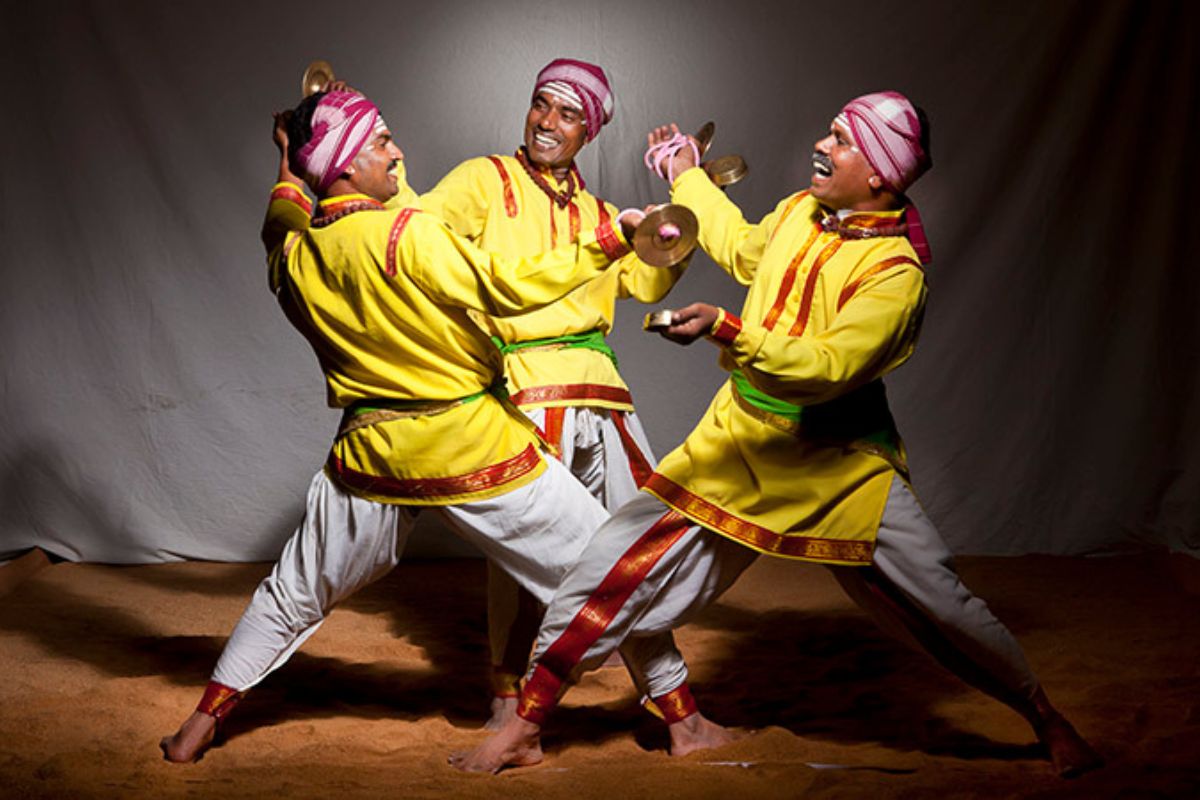
Dancers create musical rhythms and tempo matches with prayers for Lord Mahadeshwara through their performance that uses one cymbal held close while using the other in their extended right hand. Through its defensive and offensive dance sequences the Beesu Kamsale reveals the martial tradition which belongs to the Kuruba people. This cultural expression represents more than mere entertainment – it embodies a sacred oath or ‘diiksha’ that artists take, dedicating themselves to a life of devotion to Lord Mahadeshwara.
Beesu Kamsale operates as a powerful religious artistic form because it bends rhythm and movement with devotion into performances that transcend both physical and sacred domains. The number of dancers performing instrumental music will fall between three to eight members yet rises to eight to twelve when live singing is included in the performance. The artist Kamsale Mahadevaiah of Mysore plays an essential role in conserving and expanding this art form because he represents Indian culture in international cultural exchanges and works to promote its preservation.
Suggi Kunitha: Celebrating Harvest Through Dance
Karnataka displays Suggi Kunitha as its most energetic harvest festival dance which links closely to farming schedules and local traditional practices. This dance performed mainly by farmers and specifically the Halakki tribe from Uttarakannada coastal area celebrates harvest celebrations and gratitude towards natural resources. The dance commences through enthusiastic drumming which raises the excitement because a skilled drummer induces dancers to join with his fast-paced beats. The festive ambience grows stronger thanks to the foot anklet jingles which create a complex auditory symphony. Artists dress in eye-catching costumes which showcase their outstanding turban ornamented with natural-color accessories in red, green, yellow and white.

The ornate headpiece includes wooden birds and flowers as well as peacock feathers to represent the connection between human beings and nature. During dance performances twelve to fourteen dancers perform rhythmic movements while playing drums and moving with sticks and peacock feathers. During performance the dancers visit several villages to receive both grain and cash donations as they constantly dance. The dance choreography expands across the production through a sequence of movements from slow to increasingly fast-paced until its final energetic stage resembles ocean waves and plant growth and water currents.
The musical performance of Suggi dance occurs through three separate forms: Kire Kunitha (daily) and Hire Kunitha (five-day celebration) as well as Bola Kunitha (costumeless style). The Siddis introduced their cultural heritage to North Canara through migration and this expressive tradition continues to keep agriculture at its center while bringing people together.
Ummathat: The Graceful Dance of Kodava Women
Ummathat functions as the perfect traditional dance expression from Coorg (Kodagu) territory which reflects the refined cultural heritage of the Kodava people. The traditional dance form of Ummathat has achieved fame because Kodava women perform it in circular movements using hand-held brass cymbals. Actors present a spectacular sight through their traditional red brocade sarees and exquisite jewelry combined with the placement of vermilion on their foreheads. The religious importance of Ummathatt lies in its dedication to Goddess Cauvery because she plays a central role in the cultural and spiritual life of the Kodagu region. Ummathat appears at multiple religious and festive events and celebratory ceremonies because it fulfills both devotional and celebration needs.
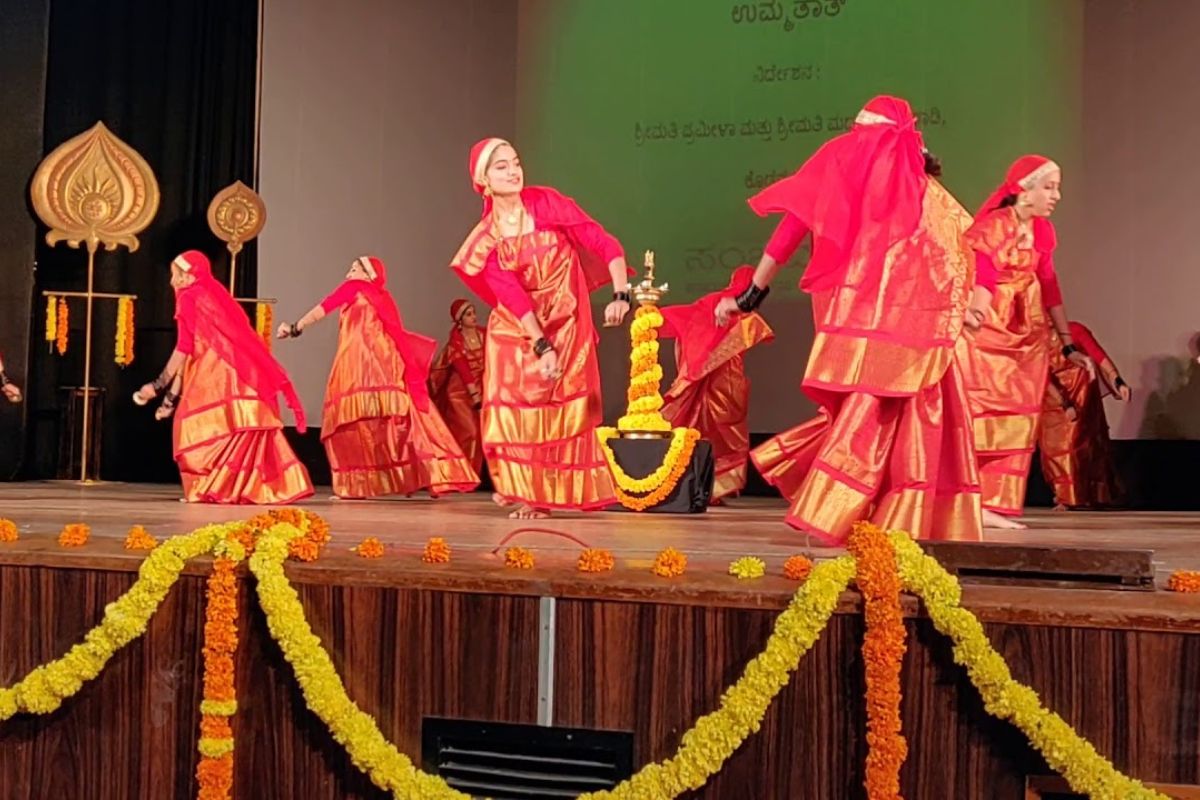
Kodava women started performing this dance tradition during field harvesting before returning home according to local agricultural customs. On the occasion of Puthari harvest festival which occurs between September and November women would engage in unstructured dancing while celebrating their future harvest bounty. The performance starts through worship directed toward Goddess Cauvery and proceeds with musical tributes that honor the Kodagu traditions together with everyday life events. Padma Shri Rani Machaiah, known as ‘Ummathat ki Rani,’ has made remarkable contributions to preserving and popularizing this folk dance over the past 60 years.
At 80 years old she continues to train more than 10.000 girls in this artistic performance. Machaiah introduced modern and energetic dance elements to the traditional performance style after the original movements progressed at a slower pace. Through her dedication she received Padma Shri recognition because of her life-long commitment to save this cultural asset for generations to come.
Puja Kunitha and Togalu Gombeyaata: Expressions of Devotion and Storytelling
The unique religious dance Puja Kunitha facilitates devotion to Goddess Shakti through expert physical dance talents and artistic creativity. The most distinctive feature of this dance form is the five-feet high bamboo frame called ‘Puje’ that the dancer balances on their head throughout the performance. The object of worship consists of a five-foot high bamboo frame which artists decorate with colorful sarees and flowers while it moves as an altar for the goddess. Unlike standardized dance types Puja Kunitha delivers performers the liberty to express themselves freely because dancers perform without following predefined plotlines. Dancers display physical mastery together with religious dedication as they carry out aerial movements which preserve the intricate head decoration in perfect alignment.
The state of Karnataka holds Togalu Gombeyaata as one of its fascinating traditional performing arts because it has entertained viewers throughout many successive generations. The traditional art tradition enacts Hindu epics through puppet recreation using leather figures. The name itself reveals its nature – ‘Togalu’ meaning leather and Gombeyaata meaning puppet play. Togalu Gombeyaata maintains its crucial role in Karnataka today because it survives as one of the rare remaining traditional puppetry forms thus continuing to preserve ancient storytelling customs.
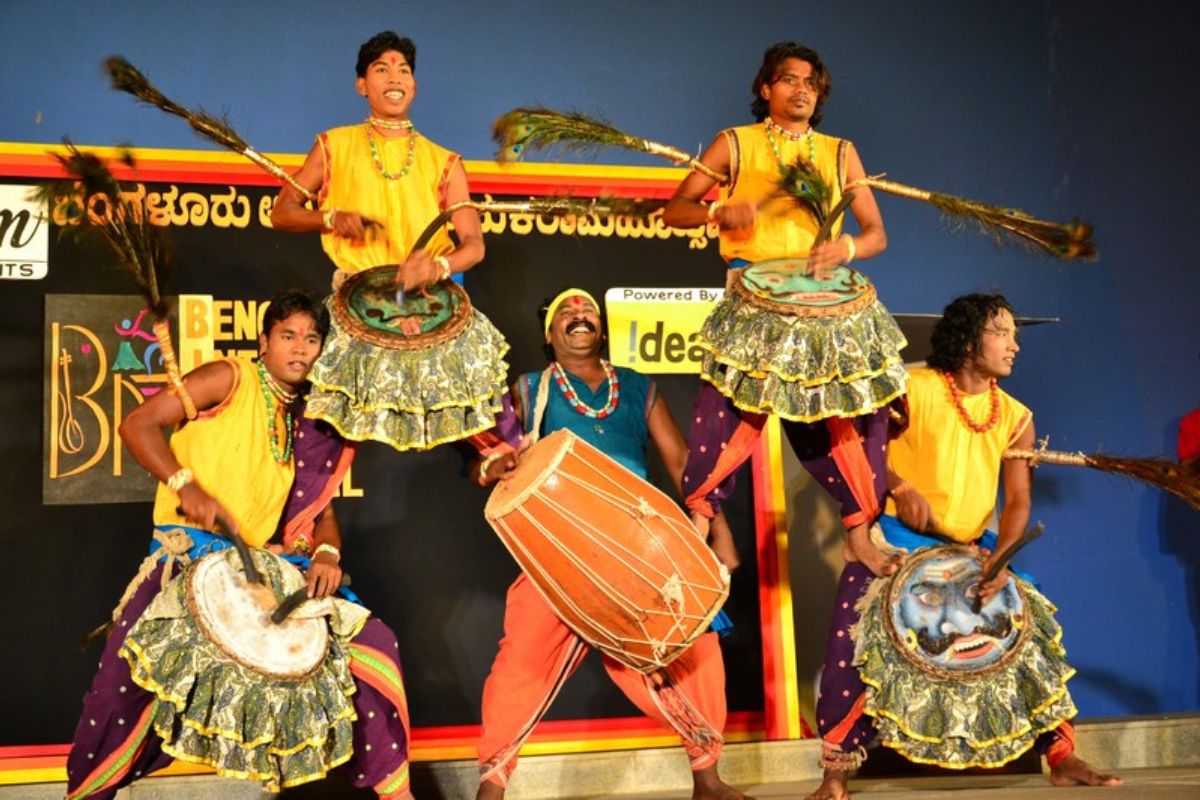
The puppet shows almost exclusively target two objectives through their performance since they function both as entertainment and rituals aimed at protecting from evil spiritual forces suspected to cause diseases and epidemics and organic losses. Translucent leather forms the basis of puppet creation through a detailed process that includes cutting and painting mythological characters. The dolls reveal vibrant shadow images against a white surface because light shines through their backs. Traditional music plays as puppet masters operate characters which they both direct through dialogue and offer narrations. There exist in Karnataka two art forms which showcase how devotion combines with entertainment and cultural storytelling to create engaging theatrical displays.
Krishna Parijatha and Yakshagana: Theatrical Treasures of Karnataka
Krishna Parijatha stands as a beloved traditional theatre tradition in Karnataka which transforms mythical stories into staged presentations. The theatrical production mostly follows the legendary duel between Lord Krishna and Lord Indra through which Lord Krishna gained possession of Parijatha tree that appeared from the cosmic ocean during the milky sea churning. People find Krishna Parijatha attractive because it connects disciplined mythological content with spontaneous laughter and clever dialogue. These dramatic works maintain straightforward narratives while using straightforward dialogue for understanding by audiences of different backgrounds as they play in outdoor venues.
The performers exhibit exceptional improvisatory abilities because they modify the storyline according to how audiences react to each performance thus creating distinct interesting theatrical experiences each time. The state of Karnataka considers Yakshagana its internationally celebrated theatrical tradition which thrives most actively in the coastal areas. A night-long theatrical spectacle combining different performance elements transforms into a spectacular dance-drama which has delighted audiences since ancient times through its intricate presentation of music, songs, dialogues and vivid costume and makeup choices.
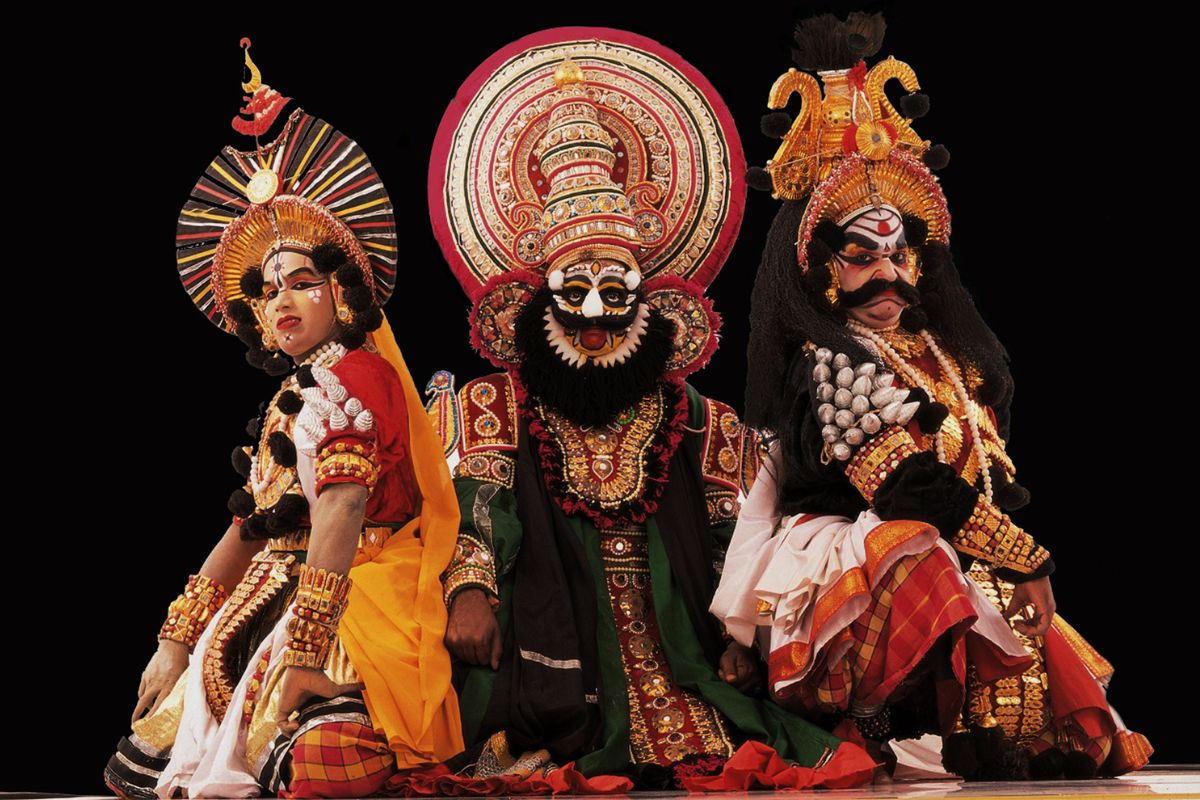
The word “Yakshagana” itself reveals its celestial nature, with “Yaksha” meaning celestial beings and “Gana” referring to music. Yakshagana performers use open-air theatre spaces near paddy fields after winter harvesting to present their shows that transport audience members into supernatural realms of mythological stories. An average Yakshagana troupe utilizes between 15 to 20 actors together with a Bhagavatha who acts as the master of ceremonies as well as chief storyteller. At the state-level Yakshagana Sammelana in Udupi the art continued to flourish as it embraced increased female performers and expanded its audience reach. Organizations attempt to obtain UNESCO intangible cultural heritage status for Yakshagana with the goal of establishing its crucial role within the cultural grounds of India.
Dollu Kunitha and Other Folk Dances: Rhythmic Expressions of Community
A rhythmic dance and percussion show honoring their deity Beereshwara arises from the Kurubas shepherd community. The dance derives its name from the “Dollu,” a percussion instrument played during the performance, which creates the pulsating beats that drive the dancers’ movements. A full Dollu Kunitha performance includes twelve performers who practice synchronized movements that match precisely with instrument rhythms.
The intense synchronization between strong drumming and the choreographed dancing performs a remarkable captivating effect which draws audiences deeply into the performance. Church authorities in Karnataka use Dollu Kunitha as a principal religious festival performance to demonstrate both community love and spiritual veneration through artistic performance. Jagghalige Kunitha represents another distinctive rhythmic folk dance featuring a unique percussion instrument made from bullock cart wheels wrapped with buffalo hides, called the “Jaggahalige.” The enormous percussion instrument produces rich sonorous sounds which support the basic structure of the dance.
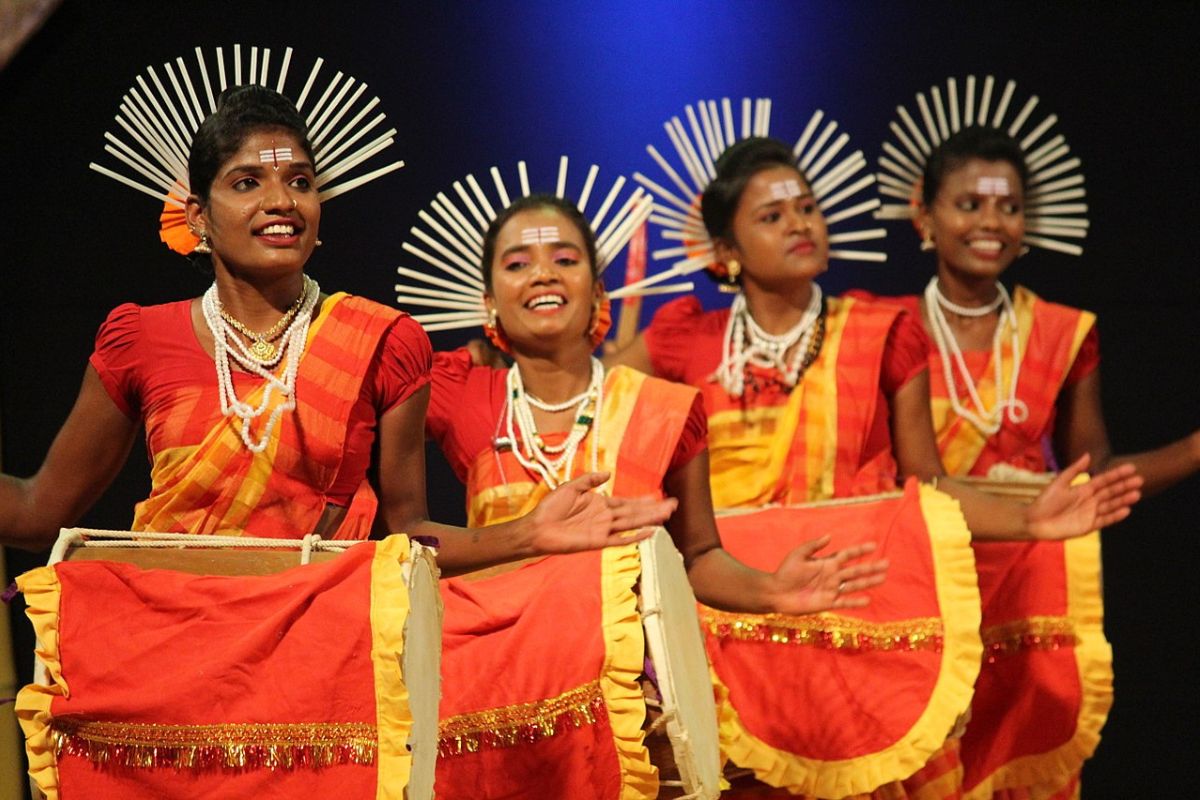
Next to 15 performers, this dance consists of marching formations which move to the strong drum beats produced by elaborate percussion instruments. The Jagghalige Kunitha dance is celebrated frequently during Ugadi and Holi festivals because its rhythms energize celebratory events. Somana Kunitha and Goravara Kunitha are two key folk performances of Karnataka state. Somana Kunitha dancers use masks while performing while Goravara Kunitha artists wear bear-hair caps and black and yellow outfits. The performers sway to the mystical tunes of flutes and small hand-held drums called “Damaruga,” often entering trance-like states during their performances.
Bhootha Aradhane and Nagamandala: Mystical Ritual Performances
Bhootha Aradhane stands as a sacred ritualistic artistic tradition which mainly appears in the coastal parts of Karnataka. The custom exists as an essential religious tradition uniting both Karnataka with its neighboring region of Kerala within Tulu worship traditions. The term “Bhootha” refers to ghostly or celestial beings that are believed to be Lord Shiva’s attendants, known as Bhuta Ganas in Hindu mythology. Throughout the ritual procession one can witness divine spirit representations while communities listen to intense drumming and observe firecrackers bursting overhead. The ceremonial event ends with placing the idols on pedestals as dancers perform with swords and bells in motions that symbolize the spirit apparitions.
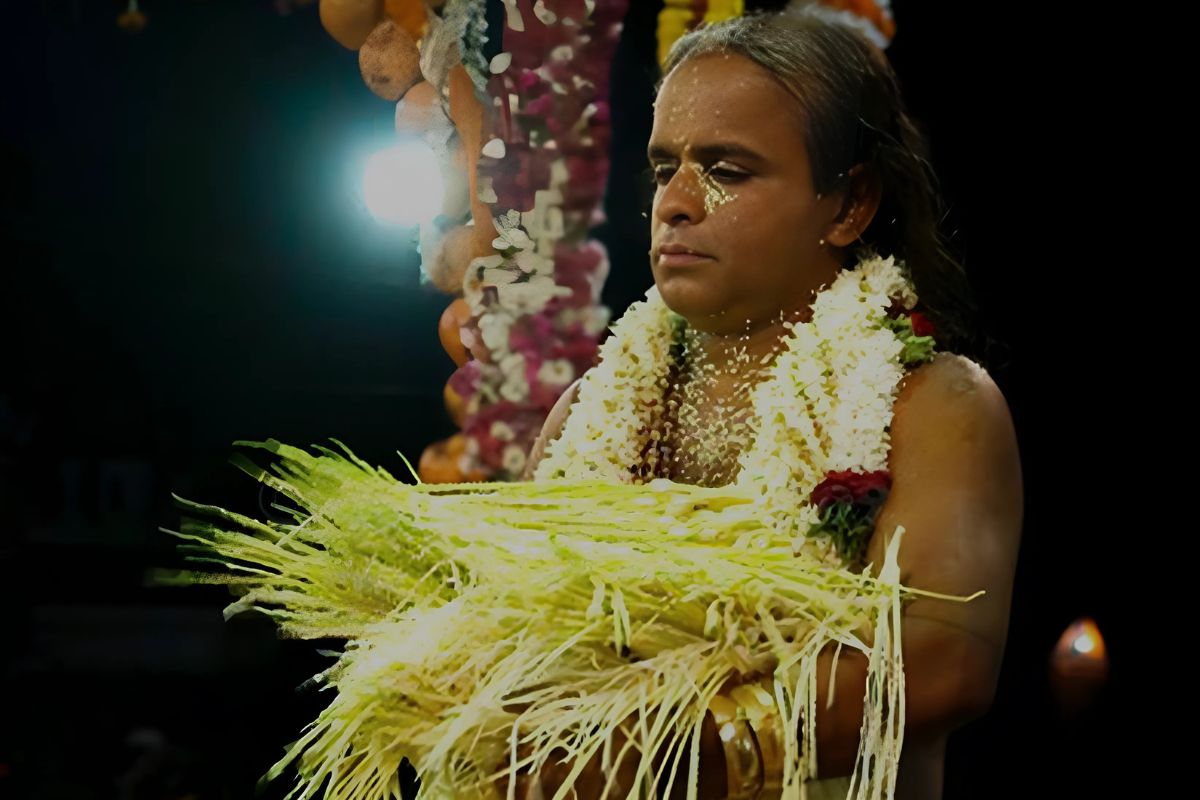
The performers induce trance states because the community believes the spirits inhabit their bodies which then function as oracular vessels to offer guidance along with predictions to the members. The wildly expressive dancing alongside states of being under spirit possession generates a strong mystical ambiance that strengthens belief systems and unites local communities. Nagamandala stands as a distinctive ritualistic performance of Karnataka which concentrates upon serpent worship through its dedicated presence in the Dakshina Kannada and Udupi districts. A complicated nighttime ceremony exists for the purpose of placating serpent entities because Hindu traditions respect snakes deeply mostly through their affiliation with Lord Shiva.
A group of Vaidya dancers perform throughout the night as nagakanyakas (serpent maidens) while moving around a complex snake theme drawn with natural pigments on holy soil. A vibrant geometric artwork functions as the central element of this ceremony from December through April during each yearly performance. The performance takes place within an erected pandal before a shrine where dancers establish a holy area for spiritual connections between humans and spiritual entities.
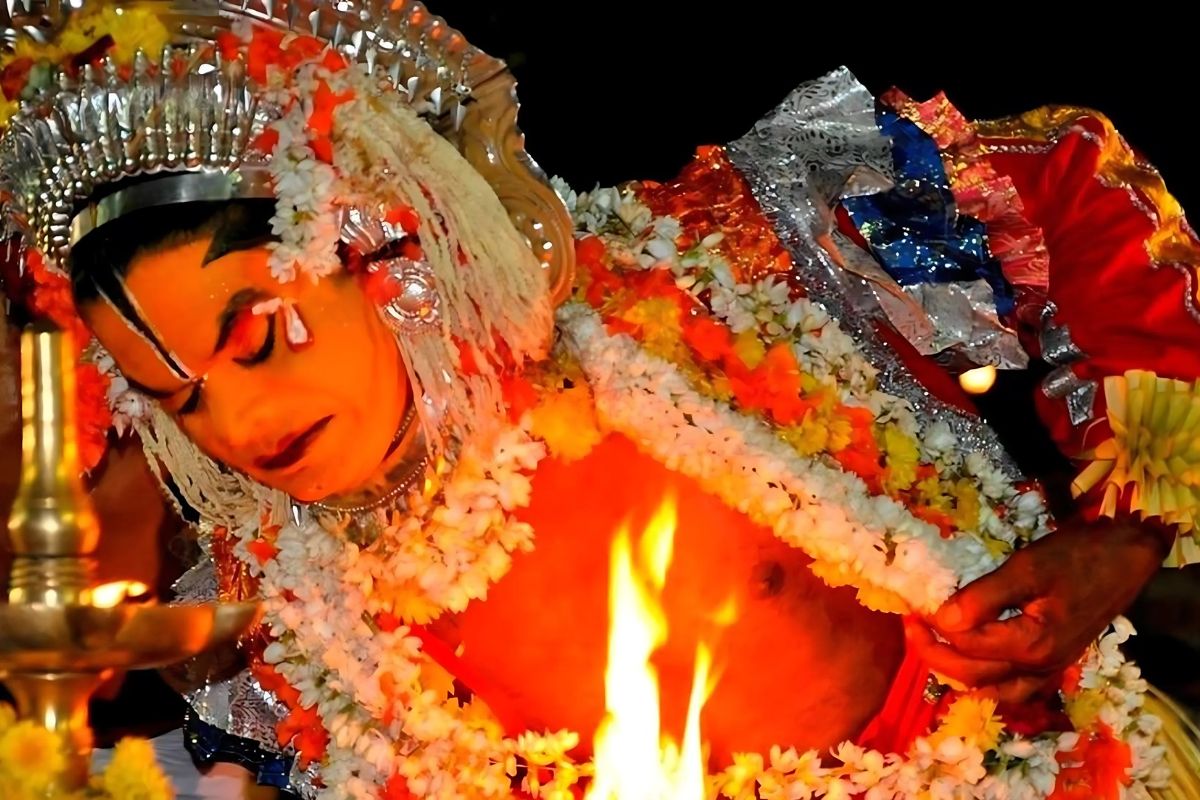
Visual Arts, Musical Traditions and Living Legacy of Karnataka
Visual arts in Karnataka have developed through countless centuries into a diverse selection of painting approaches as well as crafts and sculptural creations. Mysore paintings from the state showcase their status as exceptional visual artworks through their usage of gold leaf overlays and religious themes paired with vivid colors. Hindu deities together with mythological stories and royal compositions appear in these paintings while maintaining both precise elements and symbolic components. Wood and ivory carving joins painting as exceptional artistic traditions in Karnataka where skilled artisans develop intricate sculptures and decorative items which become architectural elements to demonstrate their skilled craftsmanship.
The musical culture of Karnataka has strengthened its impact on classical music throughout India through its influence on the development of Carnatic traditions. Numerous accomplished musicians have emerged from the state since they perfected playing the veena and flute and mridangam. Traditional folk music functions as the fundamental cultural musical expression of Karnataka where it performs as an accompaniment to all dance and theatrical events.
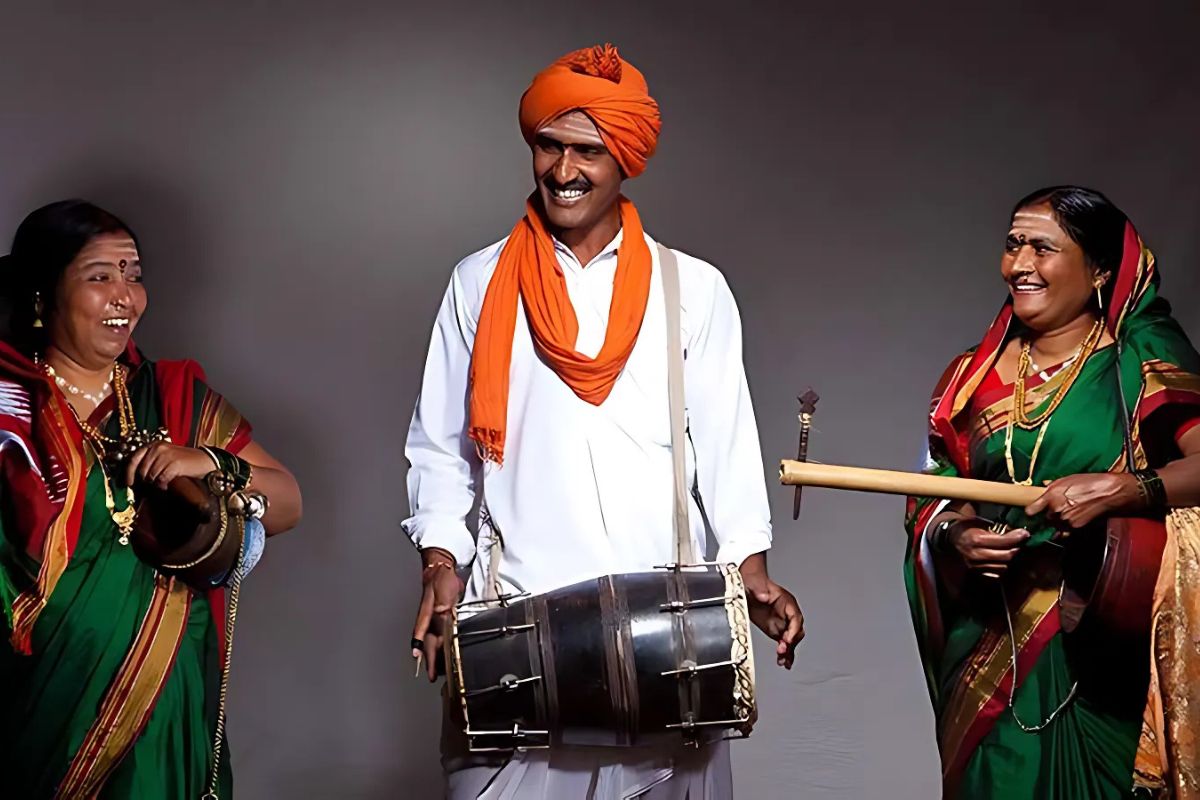
Throughout North Karnataka the Chowdike stands as a stringed instrument which female devotees use to create specific musical traditions dedicated to Goddess Yellamma. The singing performers devote their entire life to goddess praise in addition to perpetuating historical musical traditions that pass from one generation to the next through direct verbal transmission. Through music and dance the energetic practice Veeragase pays tribute to the mythical warrior Veerabhadra.
The performers showcase Veerabhadra wooden plaques in their left hands while holding swords with their right hands in a visually striking presentation that features passionate musical pieces. The multiple art expressions in Karnataka combine to form the state’s authentic cultural legacy which continues its development by sustaining ties to historic traditions. Government bodies and cultural institutions of Karnataka help protect and enhance these art forms by establishing cultural events and educational programs which maintain these precious forms as vibrant cultural expressions.
Conclusion
Karnataka functions as a collection of various artistic expressions which depict the state’s ancient cultural roots across numerous centuries. The artistic expressions in Karnataka exhibit both creative talent and spiritual profundity of its citizens through their vibrant folk dances together with elaborate theatrical performances and intricate puppetry and devotional rituals. Such traditional art expressions serve two purposes by safeguarding ancient knowledge while actively adopting modern circumstances yet staying true to their original traditions.
Each performance, whether the rhythmic beating of Kamsale cymbals or the dramatic narratives of Yakshagana, tells stories of faith, celebration, community, and connection to nature. Karnataka’s art presents an active cultural representation between past and present that connects rural customs to the growing urban interest while developing their international popularity. Through ongoing performance and advocacy for these various artistic forms Karnataka’s cultural heritage thrives for future generations to access it while enhancing both national and global cultural richness.
Also Read: Art Forms of Kerala: A Cultural Heritage of God’s Own Country
You can connect with DNN24 on Facebook, Twitter, and Instagram and subscribe to our YouTube channel.

